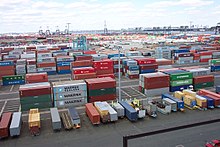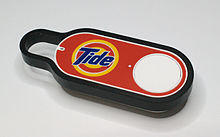Pre-Order Economy
A Pre-order economy is a type of proposed future economy that relies entirely on the business model called pre-ordering [1]. In this business model customers can place orders for items that are ahead of release or are out of stock. A preorder for an item is like a reservation for it that gives the customer guaranteed access to the item at its earliest possible availability. This type of business model is getting more common as the growth of online ecommerce and businesses continues. It can allow manufacturers to get a count of exactly how many items they need to manufacture to prevent over-production. The proposal for a full preorder economy is introduced as a more environmentally efficient model that aims to solve problems believed to be caused by unsustainable levels of production [2]. The idea is that the internet should be used to coordinate all manufacturing directly with consumer demand so that overproduction doesn’t occur. Many small online businesses have been switching over to the Print on demand model which means that their products won’t be manufactured until an order is placed. This can be especially beneficial to smaller businesses who don’t have a big enough budget to create large amounts of inventory that may have the chance of not being sold. Merchants can get a better understanding of the customers demands before even beginning the manufacturing process. This type of economy also comes with downsides like much longer wait times for the customers. The likeliness of this economy is uncertain as many consumers may value faster shipping times over all else. Companies like Amazon offer shipping times that can be as fast as overnight which isn't possible through pre-ordering.
Print on demand

A Pre-order economy would depend on a type of manufacturing process called Print on demand (POD) [3] . It allows for customers to place orders for items ahead of their production giving the manufactures a number of units that may need to be made. This process has been rising in popularity as businesses don't have to predict their market before manufacturing large amounts of any item. The certainty of preplaced orders gives the business full confidence when the time comes to create the product. Celebrities and influencers have been using this model for years as it can prevent too many products from being created as a result of the lack of market research. The merchandise will be listed online as available but wouldn't be manufactured until a certain amount of orders are placed. It even allows for smaller businesses to keep a bigger budget on hand as they don't have to spend large amounts of funds on manufacturing items with no potential customers. Many rising ecommerce companies such as Shopify.com, Wix.com, and Printify allow for simple step-by-step solutions to starting a print on demand business. It is a fairly simple process that starts with a consumer placing an order for a product. That order then goes directly to the manufacturer who is responsible for creating, packing, and shipping the product to the consumer. This cuts out the need for large amounts of products being manufactured without a direct market for them. Print on demand is a great low entry point of businesses that can be easy to set-up [4]. It is also scalable as the need for manufacturing goes up directly based on demand. The saved money can be spent on advertising rather then holding large amounts of inventory.
Benefits of a Pre-Order Economy

The idea of a fully dependent pre-order economy is introduced as a way to combat the environmental and social effects of overproduction. Overproduction is a rising problem that is caused by the lack of coordination of consumer supply and demand. An excess supply of products in a market can greatly reduce the needed demand and profit margins on a product. Companies may have accumulations of unsellable inventory waiting to be discarded or sold that not only can cause pollution [5] when wrongly discarded but can cause economic collapses of certain markets as the demand and price decrease greatly. These unsold goods cause losses in businesses that can even lead to downsizing which is when companies fire employees to stay profitable. The introduction of preordering aims to solve these problems by creating better networks and coordination between supply and demand. Since the exact amount of needed goods is known before production it is unlikely for overproduction to occur. The Pre-order strategy allows allows businesses to conduct campaigns and market research for possible upcoming products in order to better understand their markets demand. Many industries especially the gaming industry conduct preorder campaigns [6] that can last months which allow consumers to place orders for upcoming products. This also creates excitement and a bigger demand of the products allowing more people to hear about it all while spending little to no money on production. The company will then focus on advertising and marketing the product with the money received from the preorders. Studies [7] done on previous market activity by the Journal of Business Research have shown that the preorder strategy may have a direct effect with consumer product choices including how much is spent and wanting better quality. Pre ordering can also be beneficial to a consumer as they may receive special deals or unique content by being an early customer to a product. Companies like Sony have had preorder campaigns that include special offers for the early customers.
Problems with changing the current economy
For now the preorder economy is just a proposed solution to problems that may be inevitable. Many consumers value things that cant be supported by this new changed economy which introduces many potential problems. Competition between companies leads to cheaper prices, higher quality, and faster shipping times for consumers [8]. Because of services like Amazon prime people are accustomed to getting the products they need in the shortest amount of time. Pre-ordering has its benefits but when it comes to shipping times it is unable to keep up with other business models. The competition between companies may never allow for this big market change as it may be unprofitable for bigger companies to switch to a Print on demand service as opposed to what is available now. Amazon has warehouses in every state and even globally which allow for large amounts of inventory to be stored regardless of demand. This creates seamless ordering for everyday products that consumers may be looking for. A switch to a preorder strategy will drastically reduce available inventory and the time it takes to get a product. Companies are focused on providing the highest quality item in the shortest amount of time which wont be supported by a preorder economy unless massive changes are introduced to the logistics of the manufacturing process. Another large issue with this proposed economy is that not every product can be printed on demand, Many products have large manufacturing processes with multiple stages that wont allow on demand manufacturing. For example the automotive market is one that will be too logistically difficult to run using a print on demand system. It is common for car companies to allow preorders of upcoming cars [9] but it is not the most common way for consumer to shop for them and is difficult to create that on a by need basis. This would also effect dealerships who make money by having large amounts of inventory available on property which gives the consumer comfort in trying and getting a closer look before making a large purchase. It would be logistically difficult to change the way the entire market functions which is why the likeliness of this type of market is uncertain.
Emerging technologies

The constant innovation of technologies keeps introducing new ideas and tech that supports this economic proposal. The rise of the Internet of things (IoT) is connecting more and more devices together [10] which can be used to collect consumer data that can gives businesses a better understanding of consumer demands. Smart fridges are fairly new but are now able to do things such as automatically order milk when it is low or keep track for when you may need to reorder certain items [11]. This gives us a glimpse at what the future of preordering may look like. As more and more devices are connected together and collecting data there's new seamless ways to do everyday tasks. Many companies are competing in creating the newest greatest innovation in this field. Amazon even created a product called Amazon dash which is a small electronic device which can be placed around the house and programmed to order everyday items before you run out. Hp instant ink is a service that lets your printer communicate with hp when its low on ink and they will automatically send you new ink before you run out. These new technologies have a lot of potential to be integrated in different ways to coordinate the supply and demand of the world in order to help prevent overproduction and other problems related to lack of said coordination. Almost every industry is working on finding the new ways to make life easier for consumers. Many new smart homes are filled with technology that allows for them to preorder products in relation to when they will need them. Its uncertain how likely it is for the entire economy to switch to a preorder strategy but there will always be a new tech that may take us a step closer.
References
- ^ "How Pre-Orders Can Help Your Business (2022)". Shopify. Retrieved 2022-11-30.
-
^ Gessler, Arthur; Grossiord, Charlotte (2019-04).
"Coordinating supply and demand: plant carbon allocation strategy ensuring survival in the long run". New Phytologist. 222 (1): 5–7.
doi:
10.1111/nph.15583.
ISSN
0028-646X.
{{ cite journal}}: Check date values in:|date=( help) - ^ "What Is Print On Demand? How Does The POD Business Work?". Retrieved 2022-11-29.
- ^ "Pre Order Marketing: How Does Pre Order Work for eCommerce". NEKLO - Software Development & System Support. 2021-05-17. Retrieved 2022-11-30.
- ^ "The 8 Forms of Lean Waste, Applied to Business: Overproduction". Ideawake. 2018-11-26. Retrieved 2022-11-30.
- ^ "Why It's Critical To Increase Pre-order Sales | Xsolla". xsolla.com. Retrieved 2022-11-29.
- ^ "Journal of Business Research | ScienceDirect.com by Elsevier". www.elsevier.com. Retrieved 2022-11-30.
- ^ "The Importance of Competition for the American Economy | CEA". The White House. Retrieved 2022-11-30.
- ^ "Pre-order Vehicle | Help Center | Carvana". Carvana.com. Retrieved 2022-11-30.
- ^ "What is IoT (Internet of Things) and How Does it Work? - Definition from TechTarget.com". IoT Agenda. Retrieved 2022-11-30.
- ^ Bohn, Dieter (2016-01-05). "Samsung's new fridge can order Fresh Direct groceries from its humongous touchscreen". The Verge. Retrieved 2022-11-30.